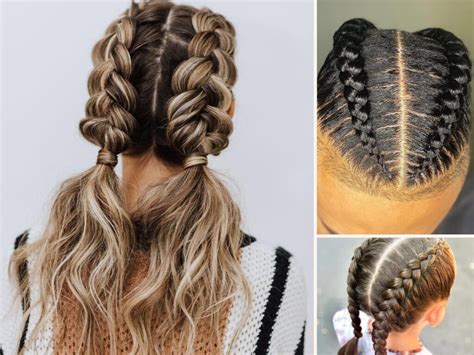Introduction
The world of braiding is a vast tapestry of intricate techniques, each with its own unique flair and appeal. Among the most popular and versatile braiding styles are the Dutch braid and the French braid. These two braids share some similarities but also boast distinct characteristics that set them apart. In this comprehensive article, we delve into the intricacies of both Dutch and French braids, exploring their differences, benefits, and applications.

Dutch Braid: The Underhand Interlace
The Dutch braid, also known as the inside-out braid, is a three-strand braid where the strands are not crossed over but under each other. This technique creates a raised, textured effect that resembles a crown, making it a popular choice for adding volume and drama to hairstyles.
Execution:
- Divide your hair into three equal sections.
- Cross the right strand under the middle strand.
- Repeat step 2 with the left strand, crossing it under the new middle strand.
- Continue alternating the strands, crossing the right under, then the left under, to create the braid.
- Secure the braid with an elastic band.
French Braid: The Overhand Interlace
In contrast to the Dutch braid, the French braid involves crossing the strands over each other, creating a flatter, more intricate appearance. The French braid is often used to keep hair out of the face or add a touch of elegance to a hairstyle.
Execution:
- Divide your hair into three equal sections.
- Cross the right strand over the middle strand.
- Add a small section of hair from the right side and cross it over the new middle strand.
- Repeat step 3 with the left strand, adding a small section of hair before crossing it over.
- Continue alternating the strands, crossing with added hair until you reach the nape of your neck.
- Finish the braid by braiding the remaining hair in a regular three-strand braid.
- Secure the braid with an elastic band.
Key Differences: Dutch Braid vs French Braid
| Feature | Dutch Braid | French Braid |
|---|---|---|
| Strand Placement | Crossed under each other | Crossed over each other |
| Texture | Raised, textured | Flatter, more intricate |
| Hair Addition | No hair is added | Hair is added with each cross |
| Volume | Adds more volume | Maintains existing volume |
| Best for | Volume, drama | Keeping hair out of face, elegance |
Benefits of Dutch and French Braids
Dutch Braids:
- Adds volume to fine or thin hair.
- Conceals hair extensions or hair pieces.
- Creates a statement-making look.
- Protects hair from damage.
French Braids:
- Prevents hair from tangling.
- Keeps hair out of the face during activities.
- Adds a simple but elegant touch to any hairstyle.
- Can be customized with various patterns and accessories.
Applications: Dutch Braid vs French Braid
Dutch and French braids have a wide range of applications, depending on their desired effect.
Dutch Braids:
- Updos: Dutch braids can be incorporated into updos to add volume and create intricate designs.
- Ponytails: A Dutch braid can be used to create a unique and stylish ponytail.
- Half-Up Braids: Half-up Dutch braids are ideal for keeping hair out of the face while maintaining a polished look.
- Accessorizing: Dutch braids can be embellished with beads, ribbons, or hair clips to create a whimsical or sophisticated accessory.
French Braids:
- Braided Headbands: French braids can be used to create a headband-like effect, keeping hair in place while adding flair.
- Fishtail Braids: French braids can be combined with fishtail braids to create intricate and visually appealing styles.
- Braided Buns: French braids can be integrated into braided buns to add texture and sophistication.
- Elaborate Updos: French braids can be combined with other braiding techniques to create elaborate and stunning updos for special occasions.
Pain Points and Motivations: Understanding the Customer Perspective
To truly understand the appeal of Dutch and French braids, it’s important to consider the pain points and motivations of those who use them.
Pain Points:
- Time-Consuming: Braiding requires time and patience, especially for elaborate styles.
- Tangled Hair: Braiding can sometimes lead to tangles, particularly if not done properly.
- Hair Damage: Tight braiding can put stress on the hair and cause damage over time.
Motivations:
- Convenience: Braids offer a convenient way to keep hair out of the face during activities or while sleeping.
- Style: Braids can add a touch of style and sophistication to any outfit, from casual to formal.
- Volume and Texture: Braids can create volume and texture in fine or flat hair, enhancing the overall appearance.
Conclusion
Dutch and French braids are versatile and elegant braiding techniques that offer a range of benefits and applications. While the Dutch braid creates a raised and textured look, the French braid offers a flatter, more intricate appearance. Both braids can be customized to suit personal style, from simple and functional to elaborate and eye-catching. By understanding the key differences, benefits, and applications of Dutch and French braids, you can harness the power of these timeless braiding techniques to create hairstyles that turn heads and enhance your overall look.
